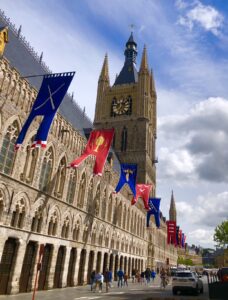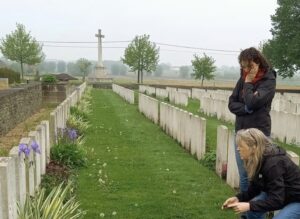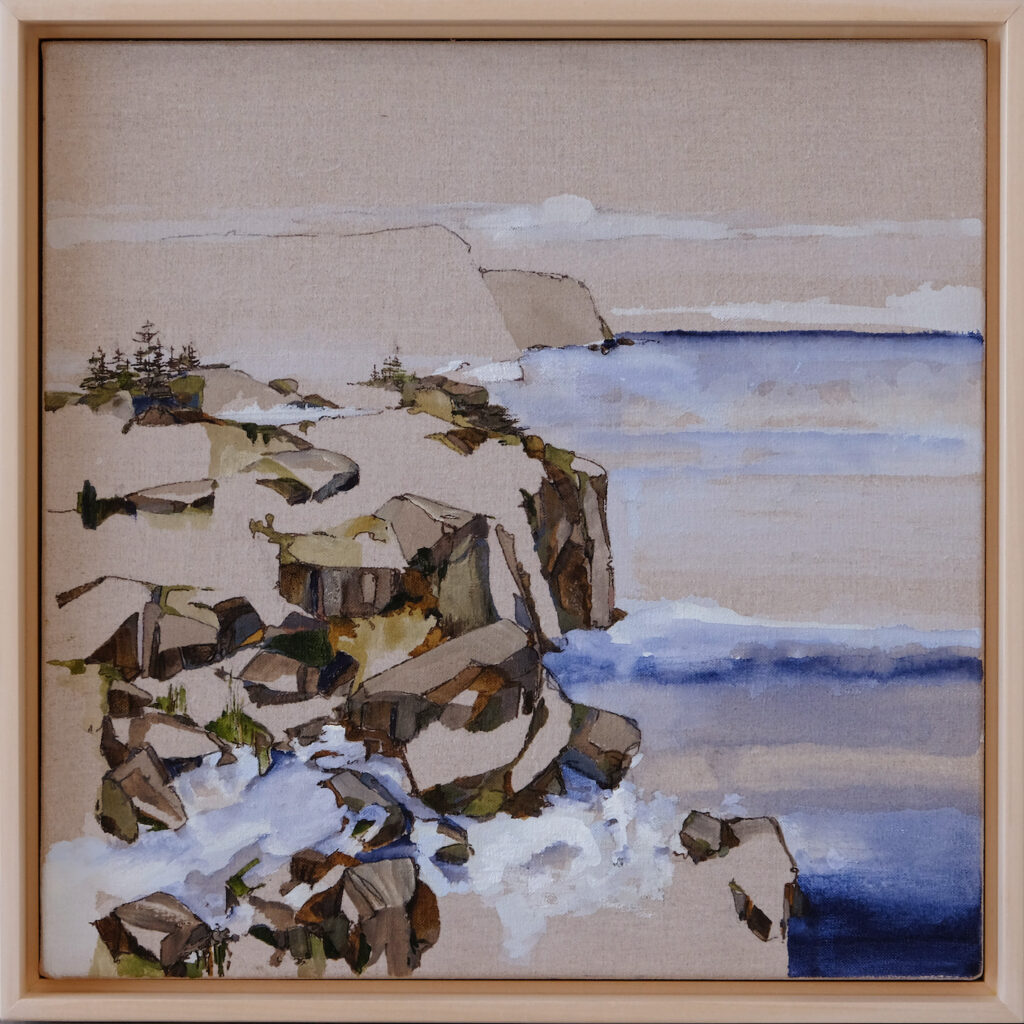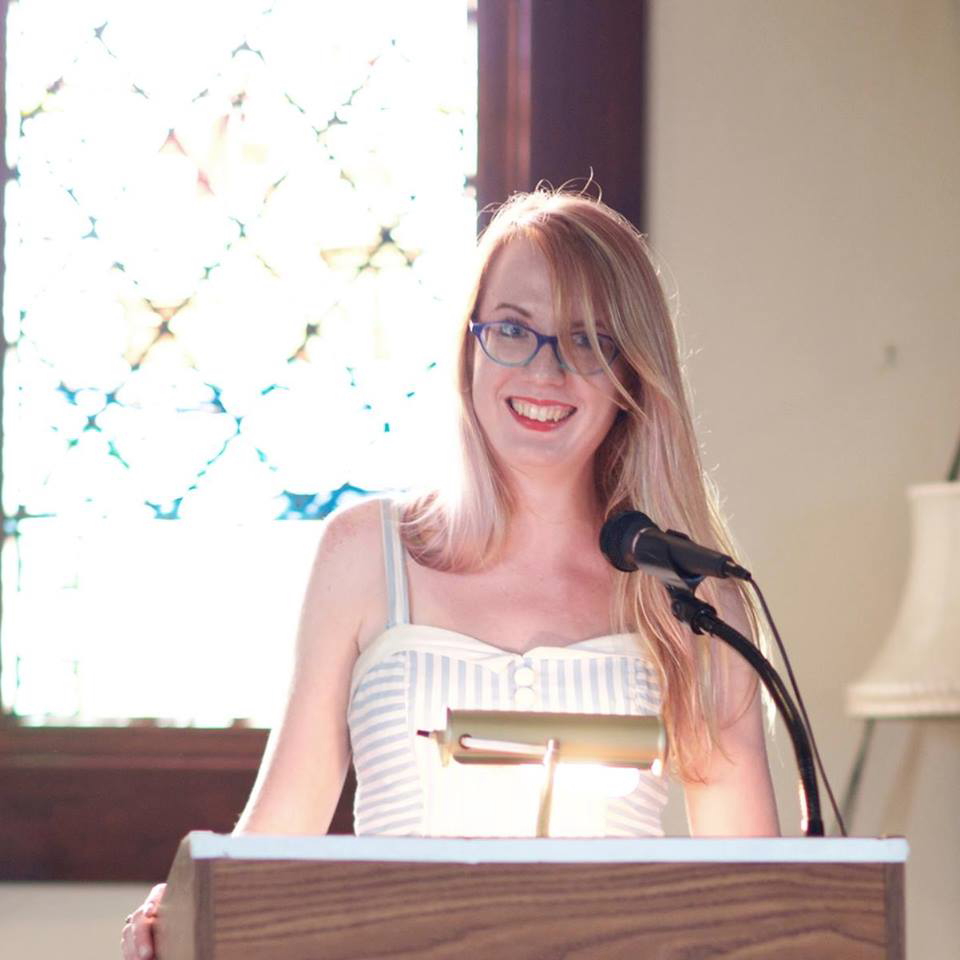Missing: One Grandfather, near Ypres, 1918: Marie Stamp follows a RNR soldier’s footsteps
June 2024
Travelling by train through the rolling farmland of Flanders’ fields, sweeping past small red-bricked towns and muddy furrows waiting for seed, the glint of sunlight on slim white slabs catches the eye. These are the Commonwealth War Graves where so many men from Newfoundland and Labrador have lain for a century.
I made this journey in April to volunteer at In Flanders Fields Museum in Ypres, hoping to gain some understanding of what happened here in 1918 to my grandfather, Private James (Jimmy) Stamp of St John’s. He survived, but never spoke of it. The repatriation of an unknown soldier and the rededication of our National War Memorial in St John’s this year made me want to know more about our family’s connection to the Great War. I wanted to find some way to process the damage it caused, and to explain why this war still lingers in our collective memory.

(Photo: The Cloth Hall, Ypres, home to the In Flanders Fields Museum, credit: Marie Stamp)
I found records of the Royal Newfoundland Regiment in the provincial archives online at The Rooms, along with the regimental diaries documenting the “Last 100 Days” of the war my grandfather fought in Belgium. This information would allow me to follow in his footsteps, imagine his experiences more vividly, and perhaps fill some of the empty space Jimmy left in our family. We know almost nothing about this quiet man, only that he had a talent for automobile engines. I have only one unflattering photo of him, taken off guard, shortly before his death in 1962. He left nothing in writing, no one remembers anything he said, and we have no relic of him except his brass Victory Medal, commemorating his participation in “The Great War for Civilisation”.
Jimmy Stamp was 18 and only slightly under-age when he enlisted in November 1917. The legal age for military service was 19, but a look at service records suggests that any eager young fellow claiming to be past his 18th birthday was taken on, no questions asked. By the time Tommy Ricketts from White Bay was awarded the Victoria Cross for bravery at 17, he was already a two-year veteran. When Ricketts enlisted, he claimed to be aged ‘18 and 3 months’.
Six months of boot camp in England followed enlistment, bringing the boys closer to legal age by the time they joined battle, but it is difficult not to chafe at the army’s lack of diligence, and it is disturbing to be confronted by the graves of so many teenagers among the Commonwealth War Graves. I wondered how it felt for Belgians who see this every day, who live among the more than 30,000 foreign sons, brothers, lovers, husbands, and fathers from 1914-1918 who lie here. I hoped to meet some people at the museum who could tell me.
The museum is in the old Cloth Hall, a gigantic gothic structure that has towered over the pretty town of Ypres for most of the last 700 years. Its rows of pointed arches are topped with narrow gables with bright yellow shutters; gracile spires surround the great clock, and its bells fill the air with a bubbly melody every fifteen minutes. It seems too perfect for something so old, and there is something surreal about how everything looks simultaneously old and new. Ypres’ architecture seems to deny that anything bad ever happened here.
My host Piet Chielens, a founder and retired director of the museum, explained that the Cloth Hall and entire town had been flattened in 1915. Winston Churchill, later British Prime Minister but then the former First Lord of the Admiralty, wanted its ruins to stand as a permanent reminder of the war’s devastation, but the surviving townspeople objected to being defeated in that way. Lost buildings from the 13th to 19th centuries were made to reappear as new, stone by stone, in the 1920s.
Getting at what people were feeling and thinking back then is a significant part of the museum’s exhibitions and approach. Visitors can interact with display panels to learn the personal stories of hundreds of people who came here from around the world, including Newfoundlanders like Tommy Ricketts, and gas-mask inventor Dr Cluny MacPherson. It is a great credit to Piet Chielens, and well worth a visit.
Piet kindly offered to accompany me on the trail of the Royal Newfoundland Regiment in the last 100 days, up to the point where the regiment crossed the River Lys in the wee hours of 20 October, 1918. We were joined by Karen Derycke, a locally-born historian at the museum’s research centre.
Our first stop was the British cemetery at Dadizele. At least 19 of my grandfather’s comrades lie there, all killed in the last weeks of the war. One of them was 16-year-old Thomas Brinton from Bulls Cove in Burin, killed on the 14th of October. We stood by his grave and were silent for a bit. What to say? I began to wonder if it was simply the inadequacy of words that kept my grandfather so quiet.
I asked Karen how her grandparents spoke to her about this war when she was growing up. To my surprise, she answered that they did not speak of it at all. As children, she and her friends ran around the fields, climbed the low walls surrounding the graveyards, and skipped around the headstones. It took time, and a personal interest in history, for her to feel differently about it, and now she talks gently to her own children about the past.
She told me about the museum’s The Lost Keys project: bronze replicas of antique house keys are laid into the paving stones of Ypres to remember the names and ages of townspeople who were killed there. It is a way of encouraging remembrance, gratitude, and awareness, and Karen’s four-year-old daughter is fascinated with them. We observed that perhaps it is easier to come to grips with great suffering when events are long in the past, when grief and fear no longer threaten to overwhelm us.

(Stamp and Karen Derycke at the New British Cemetery in Dadizele, looking at the grave of 16 year old Thomas Brinton from Burin, credit: Piet Chielens)
We continued to Courtrai, where my grandfather’s war ended with a gunshot wound as they secured the area. He and the rest of the battalion had spent the day practicing, and the entire freezing night fording the river Lys with heavy gear on their backs, in the dark, on teetering floating duckboards that sank two feet into the water under their weight. On the other side was a rising riverbank that the exhausted men in wet boots had to climb. That riverbank is identified as the location of one of six caribou statues that commemorate the regiment in Europe, and is the only one in Belgium. It is overshadowed by untamed tree growth now, and the animal stares out over four lanes of traffic and a gas station.
The trail of the regiment then seems to disappear under the asphalt just near the point where Jimmy himself went missing on 20 October. Two days later, he was accounted for at a Casualty Clearing Station, being treated for a wound to the left forearm. My father remembers how, as a boy, his eyes were drawn to that mangled-looking scar, and regrets that it was never discussed.
After his injury, Jimmy Stamp did not rejoin his comrades for the final march beyond Courtrai or for the Victory Parade through London. Medics found him unfit for any further marching because he had “flat feet, 3rd degree.” He may have been relieved, or embarrassed, beyond caring, or anxious to forget it all as soon as possible. We will never know. He was shipped back to England and then home to St John’s in February 1919, where he lived out the rest of his life quietly, keeping all his feelings and stories to himself, and leaving our questions unanswered.
Marie Stamp is a native of St John’s who lives in Ireland.
(Photo at top): The Caribou Memorial to the RNR at Courtrai, Belgium, credit: Marie Stamp)
Further reading/resources:
GWL Nicholson, The Fighting Newfoundlander, a History of the Royal Newfoundland Regiment (1964)
The Long, Long Trail: Researching Soldiers of the British Army in the Great War of 1914-1918 (longlongtrail.co.uk)
Heritage Newfoundland and Labrador (heritage.nf.ca)
In Flanders Fields Museum (inflandersfields.be)
The Rooms (therooms.ca)
The Royal Newfoundland Regiment Museum (rnfldrmuseum.ca)
The Western Front Association (westernfrontassociation.com)



